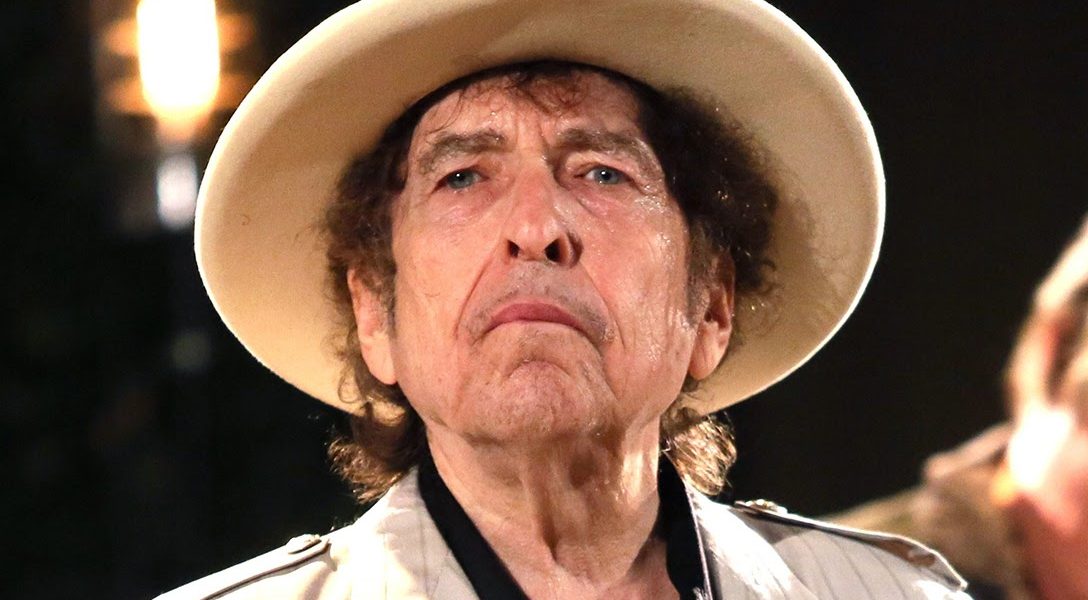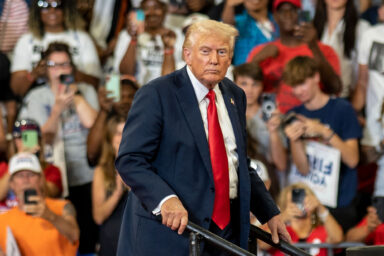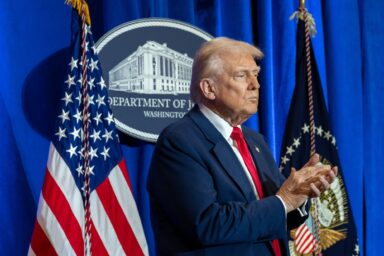The pundits missed the point: Dylan says a conspiracy killed JFK — and led his generation down a rabbit hole.
— OPINION —
In the rash of hot takes that followed Bob Dylan’s release of a previously unknown track, most commentators tiptoed around the true news value: a major cultural icon has boldly given voice to a widely held, but professionally radioactive belief: that John F. Kennedy was killed, not by the “lone nut” Lee Harvey Oswald, but as part of a plot that was tantamount to a coup d’etat. And one that reshaped and misdirected his own generation and those that followed.
This is an intriguing topic, but most commentary on the newly released track came from writers who were either ill-informed about its controversial subject or felt more comfortable in some safe corner (competing to catalog the song’s many cultural references, while skirting the big picture).
A few writers, like Berkeley professor Timothy Hampton, come close to the heart of the song. But even these interpretations head off into the weeds, making the Kennedy assassination a jumping-off point for other observations — in Hampton’s words, that Dylan is ruminating “about what constitutes an event, and about how an event takes on meaning beyond itself.” Music journalist Tim Sommer gets it right: “Bob Dylan … is sadly but firmly stating that his generation were so easily distracted by the shiny objects of pop culture that they ignored a coup.” But even Sommer leaves that statement there, without explication.
Vanity Fair’s take, on the other hand, is based on a conclusion that is flat-out wrong. “Like most honest chroniclers of the assassination,” writes Michael Hogan, “Dylan invokes the conspiracies without attempting to either confirm or deny their validity.”
That couldn’t be further from the truth. In this song, Dylan is clearly saying Kennedy was killed by a group of conspirators so that they could seize power. He’s saying it happened before our very eyes, and that Dylan’s generation — the cohort he supposedly represented in the 1960s, when the press dubbed him “the voice of a generation” — couldn’t or wouldn’t see it.
Dylan is hardly alone in making the claim. Even a governmental body, the House Select Committee on Assassinations, declared in its final report, released 16 years after Kennedy was assassinated in Dallas, that it looked like a probable conspiracy. Public sentiment in most opinion polls leans that way too, and there are enough books and movies making the case to fill a small library. Jesse Curry, chief of the Dallas Police Department at the time of the event, would later write:
We don’t have any proof that Oswald fired the rifle, and never did. Nobody’s yet been able to put him in that building with a gun in his hand. And the few who have bothered to study the voluminous exhibits accompanying the Warren Commission Report know how often the panel’s own evidence contradicts its conclusions.
No less than Bobby Kennedy, the attorney general under his brother, in the hours after Dallas turned to CIA Director John McCone, demanding to know if the agency had been involved. Bobby himself would five years later be taken out, reportedly by another person characterized as a “lone assassin.”
But Dylan is Dylan. And what he has to say — plus how he says it — matters to more people than, say, the independent journalists and amateur researchers who have pursued this story for more than half a century.
The songwriter reminds us again and again, in graphic imagery, that this act was bloody and brutal. His point isn’t obscure or philosophical. It’s direct, and even plain: an unnamed “they” killed the king to seize his kingdom, as conspirators have always done.
Dylan is saying that the seminal event of the 1960s was a magic trick, a coup, an act of misdirection that shifted history before the eyes of a world that would not or could not see.
Then, the song says, a generation built its own world on an architecture of illusion.
The Track
Observers have tended to assume that the song is recent. Perhaps it is, but Dylan’s voice seems more ragged on his recent recordings. Judging by the tone of Dylan’s ever shifting whiskey-and-cigarette vocal overtones, “Murder Most Foul” sounds more like something from his “Time Out of Mind” era in the 1990s.
Whatever its provenance, however, the commentators who tried to decode its historical and cultural references are playing games on the song’s surface without looking beneath it. This is no “American Pie,” no upbeat folk-pop confection meant to be deciphered at parties or on first dates. Everything about the song, from the gravity of Dylan’s delivery to the somber strings layered behind him, tells us that this is serious business.
Let’s start with that title. “Murder most foul” is the phrase used by the dead king in Shakespeare’s Hamlet, as he tells his son, heir, and namesake that he has been murdered by his own brother. The words were chosen by a songwriter who is also an extraordinarily literate and careful reader — so much so, in fact, that he has been accused of “stealing” lyrics and ideas from sources as varied as a retired Yakuza gangster and an obscure poet from the 19th century antebellum South. (I’m not sure how such adoptions, if true, deserve as criminal an appellation as “theft.” Personally, I hope he committed those “crimes,” and I hope he got away clean.)
The full exchange from which his song gets its title goes as follows:
GHOST: If thou didst ever thy dear father love —
HAMLET: Oh, God!
GHOST: Revenge his foul and most unnatural murder.
HAMLET: Murder!
GHOST: Murder most foul, as in the best it is,
But this most foul, strange, and unnatural.
The message seems clear enough. Dylan’s own generation, and those that followed, professed their love for JFK and what he represented. And yet, they rarely inquire into the nature of his death, much less seek to avenge it.
Premeditated. Foul. Strange. Unnatural. Mark those words. They were carefully chosen.
Premeditated
“President Kennedy was riding high,” sings Dylan, adding the traditional words of a warrior about to die: “A good day to be living and a good day to die.”
In Dylan’s telling, Kennedy is confronted by his murderers.
Being led to the slaughter like a sacrificial lamb
Say wait a minute, boys, do you know who I am?
“Of course we do, we know who you are,” the conspirators answer.
They’re talking in the language of gangsters. And the plural form — “boys” — makes it clear that Dylan believes the assassination was the work of more than one person. Dylan is rejecting the idea that Oswald fired the shots on his own, and that his bullets performed magical feats of trickery as they penetrated more than one occupant of Kennedy’s limousine.
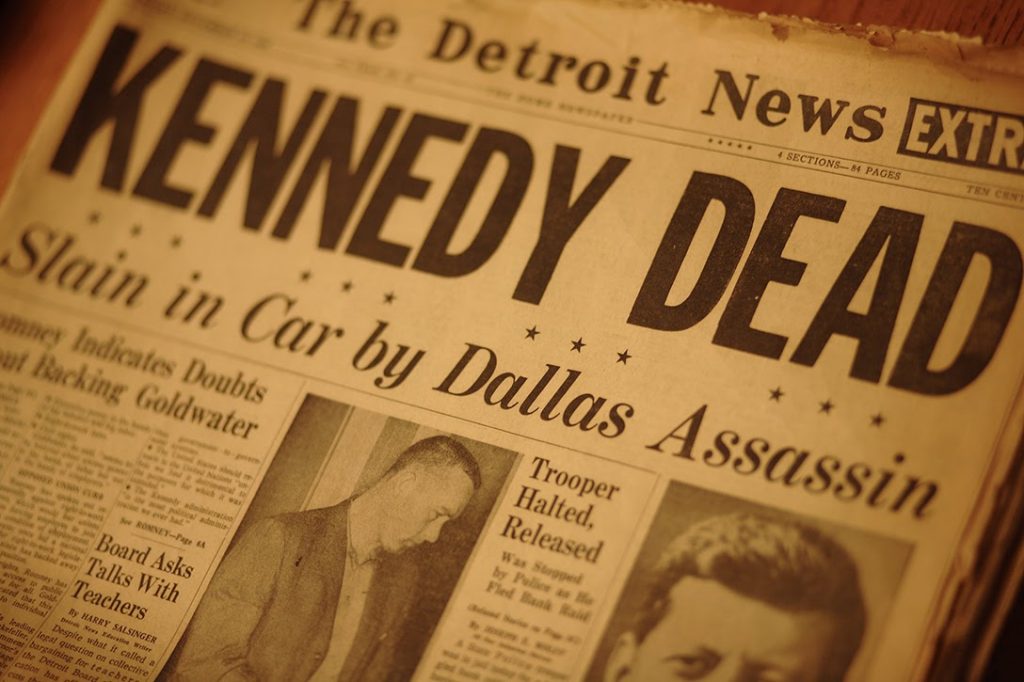
Foul
“Then they blew off his head when he was still in the car.”
Dylan doesn’t mince words. It was a brutal killing, the slaughter of a man in the presence of his wife and a cheering crowd. “Shot down like a dog in broad daylight,” Dylan sings, “it was a matter of timing and the timing was right.”
Why was it “a matter of timing,” and why was the timing right? Kennedy was reportedly at odds with the CIA after the Bay of Pigs fiasco. Other reports suggest that Kennedy may have been winding down the presence of US “advisers” in Vietnam, although this remains a matter of speculation.
How foul was the killing of the president? Dylan doesn’t mince words:
You gotta pay debts, we’ve come to collect
We’re gonna kill you with hatred, without any respect
We’ll mock you and shock you and we’ll put it in your face
We’ve already got someone here to take your place
The day they blew out the brains of the king
Thousands were watching
More than half a century later, Dylan describes the violence of the act with an undiluted intensity that startles the listener. He seems to be fixated on frame 313 of the Zapruder film, bafflingly withheld from the public for years by Time-Life, which shows a bullet shattering the president’s skull.
The media as a whole softened the violence of the act in the wake of the assassination, studiously avoiding presenting its more violent images. Those only began to appear years later. The Zapruder film was not shown on television until March 6, 1975, on Geraldo Rivera’s Good Night America. The public outrage that followed led to investigations in both the House and Senate.
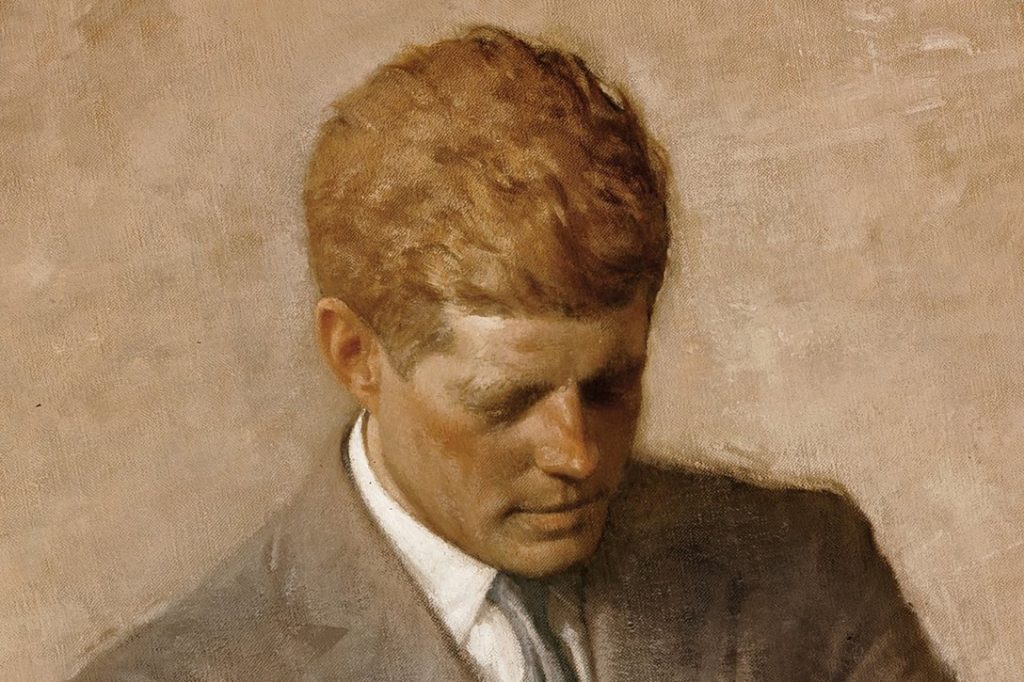
Strange
Thousands were watching, no one saw a thing
It happened so quickly — so quick by surprise
Right there in front of everyone’s eyes
“No one saw a thing.” The assassination was seen firsthand by hundreds of people, and the Zapruder film would eventually enter the public consciousness. We feel as though we saw the killing. But somehow the real act remained — and remains — invisible.
Most remember an airbrushed JFK, while the violence of his death — and the forces that might have been behind it — are rarely recalled. It’s as if everyone who lived through it suffered from post-traumatic stress disorder, excising the painful memory from conscious recall. But they had help. Here’s what is really strange: The darker implications of the assassination have been obscured by what looks like a huge and almost inexplicable collaboration involving media, government, and academia to foster the “lone gunman” myth. These unanswered questions go largely unaddressed, in a kind of collective amnesia that’s been passed on, almost epigenetically, to the generations that followed.
Unnatural
That’s some feat. In Dylan’s telling, the assassination was a masterful deception — one that led his generation into distractions and misdirection.
Greatest magic trick ever under the sun
Perfectly executed, skillfully done
Scientist’s Trick ‘Explains’ JFK Backward Movement When Shot
JFK Had Ordered Full Withdrawal from Vietnam: Solid Evidence
Magic tricks are impressive because they seem to defy the laws of nature. They are the dark side of the miraculous, an inverse of biblical deeds like walking on water or reviving the dead. Even these affirmative miracles violate the laws of nature, which is why Ralph Waldo Emerson rejected them in a speech to the Harvard Divinity School. Such miracles were “monster,” in Emerson’s words, “not one with the clover and the falling rain.”
Kennedy’s death was the opposite of a miracle. It was a dark and monstrous act that changed the course of history. We will never know how events would have unfolded if Kennedy hadn’t died on that day. Kennedy had recently signed the Limited Nuclear Test Ban Treaty, and was known to be an opponent of nuclear bomb tests.
In one of his bolder and less-remembered peace initiatives, JFK had proposed making the moon landing a joint US–Soviet mission. That idea, which could have led to a powerful shift in the culture of the Cold War, was raised just two months before his murder in Dallas.
Would JFK have de-escalated the conflict in Vietnam? Would he have done more to rein in the CIA? Or do ideas like these come from a desire to airbrush history, a sentimental impulse to elevate the young president’s memory?
We don’t know the killers’ names. Dylan implies that Lyndon Johnson knew what was happening, and that the killing was a deliberate power play. Is he right? Dylan presumably has no access to secret information. But the public record itself raises deep questions about the official story.
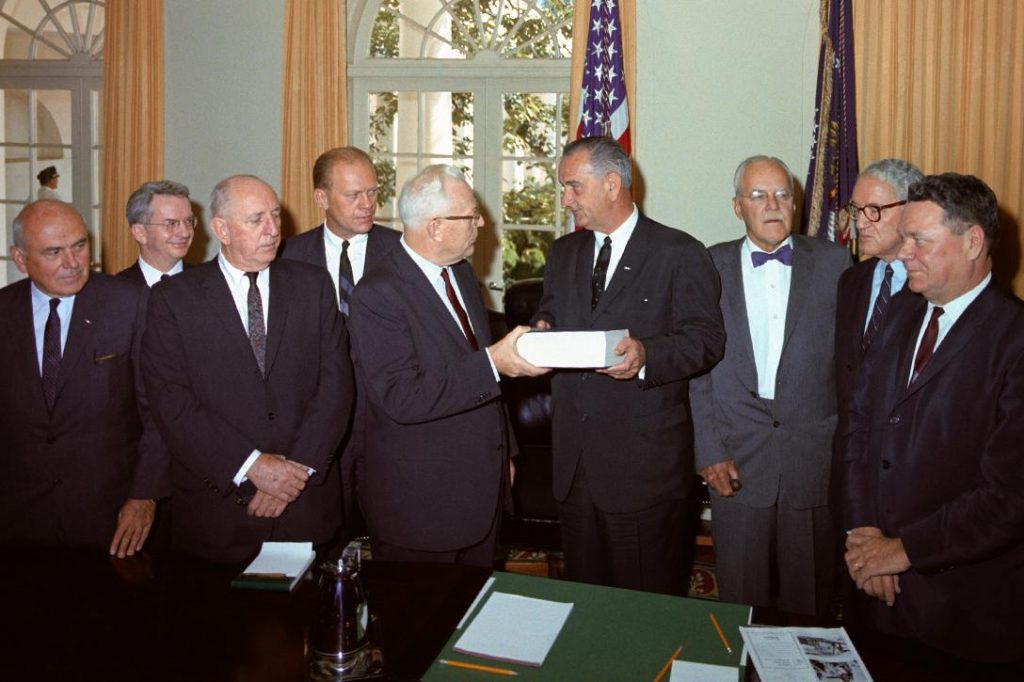
Monsters
This unnatural killing brought forth monsters, in the Emersonian sense. But in this case they are monsters that entertain. The cultural miracles of the 1960s brought forth colorful mutant foliage, flora that distracted a generation from its stolen destiny.
Dylan follows his “magic trick” lyric with a shout-out to his generation’s most famous radio personality, one who bears the name of a monster:
Wolfman, oh wolfman, oh wolfman, howl
Rub a dub dub — it’s murder most foul
Wolfman Jack, born Robert Weston Smith, first came to fame on “border radio” in 1963, the year Kennedy died. These stations were based in Mexico, where US regulations didn’t apply. They could send high-powered signals that covered much of North America. Wolfman Jack was based in Ciudad Acuña, Mexico, and he described the station this way: “We had the most powerful signal in North America … A car driving from New York to LA would never lose the station.”
He also said this: “Birds dropped dead when they flew too close to the tower.”
As anyone who has seen the old Lon Chaney films knows, a wolfman is someone who can’t suppress the monster inside him.
Merchants of Death
Dylan has some requests for the howling and disembodied voice from across the border:
Play the Merchant of Venice, play the merchants of death
Play “Stella by Starlight” for Lady Macbeth
Don’t worry Mr. President, help’s on the way
Your brothers are comin’, there’ll be hell to pay
Brothers? What brothers? What’s this about hell?
Tell ‘em we’re waitin’ — keep coming — we’ll get ‘em as well
The merchants of death have seized power, says Dylan. Soon, they will kill Robert F. Kennedy, too. Others are brothers in spirit, if not to the living JFK then to the idealistic image that lingered after his death. Who are these brothers — Malcolm X? The Black Panthers? Martin Luther King Jr.? They will meet the same fate.
In the song, Kennedy rides to his doom as Dylan marks the landmarks along the way. “Try to make it to the triple underpass,” but we already know he won’t make it to this journey’s end:
They blew off his head when he was still in the car
Shot down like a dog in broad daylight.
The road’s dark ending brings to mind the poem “The Highwayman,” by Afred Noyes, which the voracious reader Dylan undoubtedly knows. Dylan even repeats the poem’s line, “shot down like a dog”:
Blood red were his spurs i’ the golden noon; wine-red was his velvet coat,
When they shot him down on the highway,
Down like a dog on the highway,
And he lay in his blood on the highway, with a bunch of lace at his throat.
A highwayman was a thief. But Noyes’s highwayman found honor and love, and as a result was shot down by King George’s men. Could Dylan be saying that Kennedy, too, was murdered by the true powers behind the throne?
He seems to be saying that Kennedy expediently gained the presidency through some deals with bad people, then didn’t carry out his part of the bargain. “You got unpaid debts and we’ve come to collect,” the killers tell Kennedy.
“Revenge his foul and most unnatural murder”
The ghosts of the murdered cry out for vengeance. But murders can’t be avenged until the killers are identified. In Dylan’s telling, Kennedy knew his killers. In the public narrative, however, a lone and disaffected stranger murdered the president almost by chance.
If Kennedy knowingly defied some ruthless people, then to deny the existence of a conspiracy is to deny Kennedy the martyr’s death he deserves. For the generation that most admired Kennedy, the generation to which Dylan himself belongs, that would amount to a form of betrayal.
The failure to confront this betrayal arguably allowed the “coup” to stand, shifting the balance of political power and leading to decades of failure, immiseration, and inequality. As the Wolfman himself said, “Birds dropped dead when they flew too close to the tower.”
Dylan couldn’t have said it any plainer. But, if all the analyses of this song missed the point, if the commenters got lost in a maze of song references and cultural puzzle-play — well, that’s the story of Dylan’s generation, too.
“Look for me by moonlight,” says the highwayman to his lover. “Play ‘Stella by Starlight’ for Lady MacBeth,” says Dylan. “Stella by starlight,” says that old song, “and not a dream.”
The JFK assassination was not a dream, no matter how much we have ignored it or wished it away. It can’t be a dream, not for Lady MacBeth and not for us, because there is a damned spot of blood on our history and it can’t be washed away.
Related front page panorama photo credit: Adapted by WhoWhatWhy from National Archives and Alberto Cabello / Flickr (CC BY 2.0).
